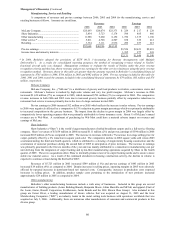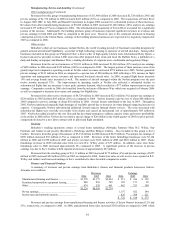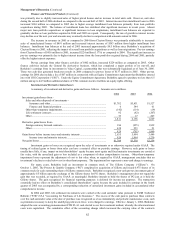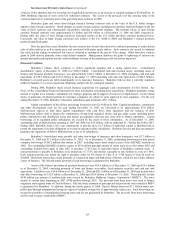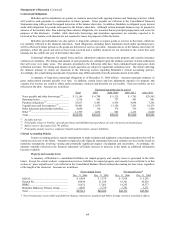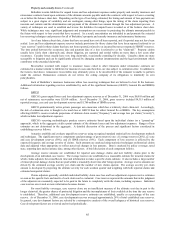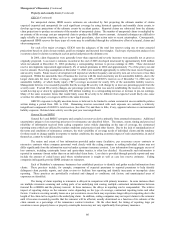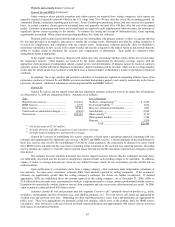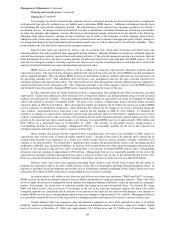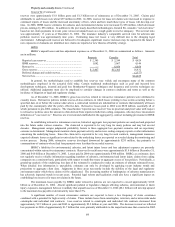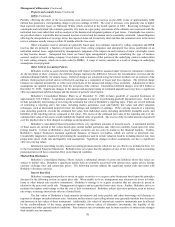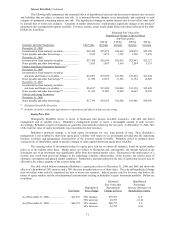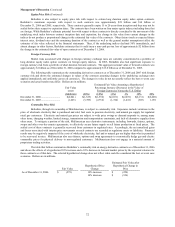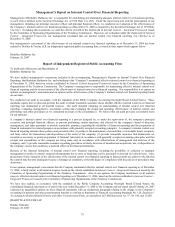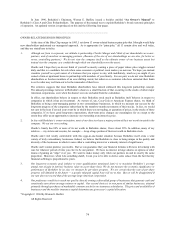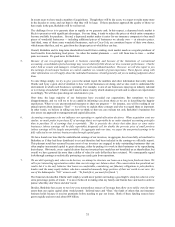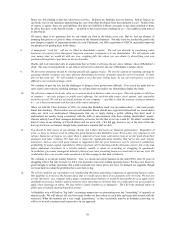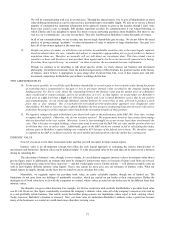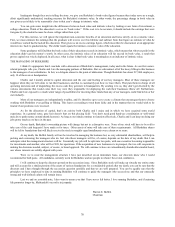Berkshire Hathaway 2006 Annual Report Download - page 69
Download and view the complete annual report
Please find page 69 of the 2006 Berkshire Hathaway annual report below. You can navigate through the pages in the report by either clicking on the pages listed below, or by using the keyword search tool below to find specific information within the annual report.
68
Management’s Discussion (Continued)
Property and casualty losses (Continued)
General Re (Continued)
Loss triangles are used to determine the expected case loss emergence patterns for most coverages and, in conjunction
with expected loss ratios by accident year, are further used to determine IBNR reserves. Additional calculations form the basis
for estimating the expected loss emergence pattern. The determination of the expected loss emergence pattern is not strictly a
mechanical process. In instances where the historical loss data is insufficient, estimation formulas are used along with reliance
on other loss triangles and judgment. Factors affecting loss development triangles include but are not limited to the following:
changing client claims practices, changes in claim examiners’ use of ACRs or the frequency of client company claim reviews,
changes in policy terms and coverage (such as client loss retention levels and occurrence and aggregate policy limits), changes in
loss trends and changes in legal trends that result in unanticipated losses, as well as other sources of statistical variability. These
items influence the selection of the expected loss emergence patterns.
Expected loss ratios are selected by reserve cell, by accident year, based upon reviewing forecasted losses and
indicated ultimate loss ratios predicted from aggregated pricing statistics. Indicated ultimate loss ratios are calculated using the
selected loss emergence pattern, reported losses and earned premium. If the selected emergence pattern is not accurate, then the
indicated ultimate loss ratios will not be accurate and this can affect the selected loss ratios and hence the IBNR reserve. As with
selected loss emergence patterns, selecting expected loss ratios is not a strictly mechanical process and judgment is used in the
analysis of indicated ultimate loss ratios and department pricing loss ratios.
IBNR reserves are estimated by reserve cell, by accident year, using the expected loss emergence patterns and the
expected loss ratios. The expected loss emergence patterns and expected loss ratios are the critical IBNR reserving assumptions
and are updated annually. Once the annual IBNR reserves are determined, actuaries calculate expected case loss emergence for
the upcoming calendar year. This calculation does not involve new assumptions and uses the prior year-end expected loss
emergence patterns and expected loss ratios. The expected losses are then allocated into interim estimates that are compared to
actual reported losses in the subsequent year. This comparison provides a test of the adequacy of prior year-end IBNR reserves
and forms the basis for possibly changing IBNR reserve assumptions during the course of the year.
In 2006, reported losses for North American workers’ compensation risks (primarily pre-2002 occurrences) exceeded
expectations. Claims data continued to show increased costs of long-term medical care and prescription drug costs and increased
medical care utilization by claimants. These developments produced changes in expectations for future development of reported
claims and resulted in increases in nominal ACRs. For prior years’ workers’ compensation losses, reported claims exceeded
expected claims in 2006 by $19 million. These developments further precipitated a $132 million net increase in nominal IBNR
reserve estimates for unreported occurrences. After deducting $33 million for the change in net reserve discounts during the
year, workers’ compensation losses from prior years’ reduced pre-tax earnings in 2006 by $118 million. To illustrate the
sensitivity of changes in expected loss emergence patterns and expected loss ratios for General Re’s significant excess of loss
workers’ compensation reserve cells, an increase of ten points in the tail of the expected emergence pattern and an increase of ten
percent in the expected loss ratios would produce a net increase in nominal IBNR reserves of approximately $548 million and
$278 million on a discounted basis as of December 31, 2006. The increase in discounted reserves would produce a
corresponding decrease in pre-tax earnings. Management believes it is reasonably possible for the tail of the expected loss
emergence patterns and expected loss ratios to increase at these rates.
Other casualty and general liability reported losses (excluding mass tort losses) were favorable in 2006 relative to
expectations after several years of relatively higher reported losses. Casualty losses tend to be long-tail and it should not be
assumed that favorable loss experience in a single year (2006) means that loss reserve amounts currently established will
continue to develop favorably. For General Re’s significant other casualty and general liability reserve cells (including medical
malpractice, umbrella, auto and general liability), an increase of five points in the tails of the expected emergence patterns and an
increase of five percent in expected loss ratios would produce a net increase in nominal IBNR reserves and a corresponding
reduction in pre-tax earnings of approximately $550 million. Management believes it is reasonably possible for the tail of the
expected loss emergence patterns and expected loss ratios to increase at these rates in any of the aforementioned reserve cells.
However, given the diversification in worldwide business, more likely outcomes are believed to be less than $550 million.
Property losses were lower than expected (including losses related to the World Trade Center) but the nature of
property loss experience tends to be more volatile because of the effect of catastrophes and large individual property losses. In
response to favorable claim developments and another year of information, estimated remaining World Trade Center losses were
reduced by $62 million in 2006, producing a corresponding increase in pre-tax earnings.
In certain reserve cells within excess directors and officers and errors and omissions (“D&O and E&O”) coverages,
IBNR reserves are based on estimated ultimate losses without consideration of expected emergence patterns. These cells often
involve a spike in loss activity arising from recent industry developments making it difficult to select an expected loss emergence
pattern. For example, the recent wave of corporate scandals has caused an increase in reported losses. For General Re’s large
D&O and E&O reserve cells an increase of ten points in the tail of the expected emergence pattern (for those cells where
emergence patterns are considered) and an increase of ten percent in the expected loss ratios would produce a net increase in
nominal IBNR reserves and a corresponding reduction in pre-tax earnings of approximately $133 million. Management believes
it is reasonably possible for the tail of the expected loss emergence patterns and expected loss ratios to increase at these rates.
Overall industry-wide loss experience data and informed judgment are used when internal loss data is of limited
reliability, such as in setting the estimates for mass tort, asbestos and hazardous waste (collectively, “mass tort”) claims. Unpaid
mass tort reserves at December 31, 2006 were approximately $1.9 billion gross and $1.2 billion net of reinsurance. Such




